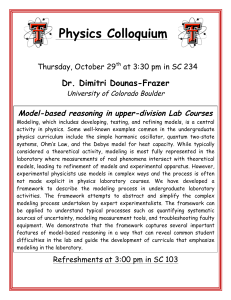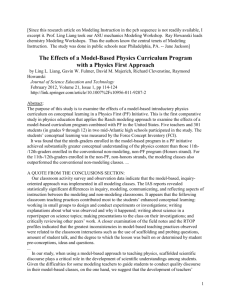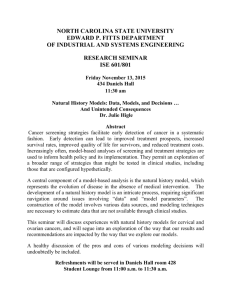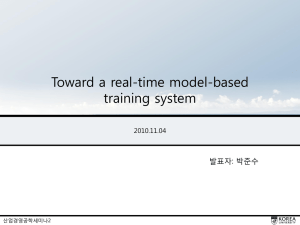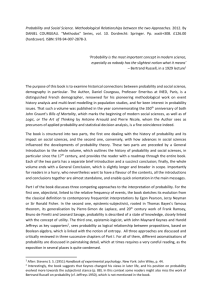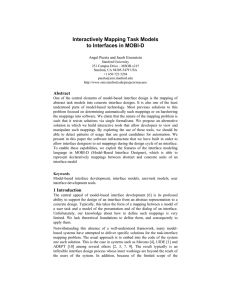The Mecano Project: Enabling User-Task Automation
advertisement
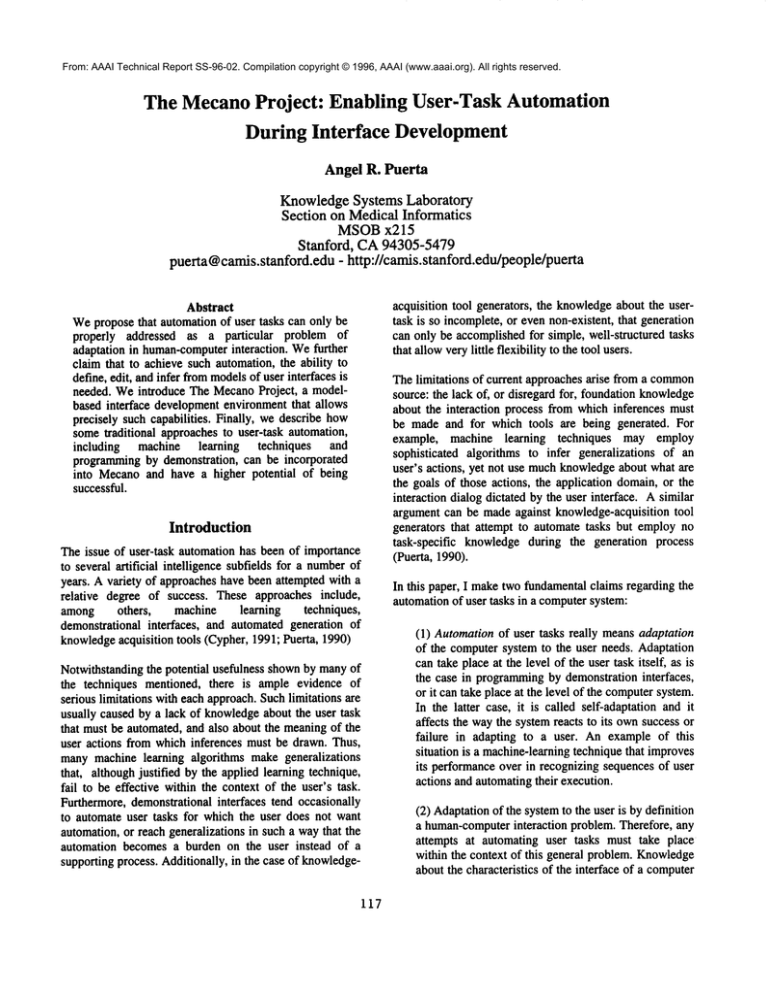
From: AAAI Technical Report SS-96-02. Compilation copyright © 1996, AAAI (www.aaai.org). All rights reserved. The MecanoProject: Enabling User-Task Automation During Interface Development Angel R. Puerta KnowledgeSystems Laboratory Section on MedicalInformatics MSOBx215 Stanford, CA94305-5479 puerta@camis.stanford.edu - http://camis.stanford.edu/people/puerta acquisition tool generators, the knowledgeabout the usertask is so incomplete, or even non-existent, that generation can only be accomplishedfor simple, well-structured tasks that allowverylittle flexibility to the tool users. Abstract Wepropose that automation of user tasks can only be properly addressed as a particular problem of adaptation in human-computerinteraction. Wefurther claim that to achieve such automation, the ability to define, edit, and infer from modelsof user interfaces is needed. Weintroduce The MecanoProject, a modelbased interface developmentenvironment that allows precisely such capabilities. Finally, we describe how sometraditional approaches to user-task automation, including machine learning techniques and programmingby demonstration, can be incorporated into Mecanoand have a higher potential of being successful. Introduction The issue of user-task automation has been of importance to several artificial intelligence subfields for a numberof years. A variety of approaches have been attempted with a relative degree of success. These approaches include, among others, machine learning techniques, demonstrational interfaces, and automated generation of knowledgeacquisition tools (Cypher, 1991; Puerta, 1990) Notwithstanding the potential usefulness shownby manyof the techniques mentioned, there is ample evidence of serious limitations with each approach. Suchlimitations are usually caused by a lack of knowledgeabout the user task that must be automated, and also about the meaningof the user actions from which inferences must be drawn. Thus, many machine learning algorithms make generalizations that, although justified by the applied learning technique, fail to be effective within the context of the user’s task. Furthermore, demonstrational interfaces tend occasionally to automate user tasks for which the user does not want automation, or reach generalizations in such a way that the automation becomes a burden on the user instead of a supporting process. Additionally, in the case of knowledge- 117 The limitations of current approaches arise from a common source: the lack of, or disregard for, foundation knowledge about the interaction process from which inferences must be made and for which tools are being generated. For example, machine learning techniques may employ sophisticated algorithms to infer generalizations of an user’s actions, yet not use muchknowledgeabout what are the goals of those actions, the application domain, or the interaction dialog dictated by the user interface. A similar argument can be made against knowledge-acquisition tool generators that attempt to automate tasks but employ no task-specific knowledge during the generation process (Puerta, 1990). In this paper, I maketwo fundamentalclaims regarding the automationof user tasks in a computersystem: (1) Automation of user tasks really means adaptation of the computer system to the user needs. Adaptation can take place at the level of the user task itself, as is the case in programmingby demonstration interfaces, or it can take place at the level of the computersystem. In the latter case, it is called self-adaptation and it affects the waythe system reacts to its ownsuccess or failure in adapting to a user. An example of this situation is a machine-learningtechnique that improves its performance over in recognizing sequences of user actions and automatingtheir execution. (2) Adaptationof the systemto the user is by definition a human-computerinteraction problem. Therefore, any attempts at automating user tasks must take place within the context of this general problem. Knowledge about the characteristics of the interface of a computer system is essential to any approach towards automation. Disregard for such knowledgewill result inevitably in techniques which either fail or face serious limitations. Acceptance of the above principles brings up immediately the question of how do we acquire, manage, and process the interface knowledgethat is required for adaptation. In any human-computerinteraction situation, we will need explicit knowledgeabout the user task, the application domain,the user, and the interface dialog and presentation. This knowledgeis likely to be available only if we design interfaces based on such knowledge sources by using sophisticated developmentenvironments that allow editing of the required knowledge and that provide automated generation facilities. This is the premise of an emerging technology called model-based interface development. In this paper, I propose that by using this technology we can produce interfaces where sufficient knowledgeabout the interaction process is available, thereby providing the foundation for any techniques that attempt to automate user tasks. The remaining sections of the paper describe the technology, our ownperspective at implementingit with a development environment called Mecano, and a proposal describing howto use techniques, such as demonstrational interfaces, within the context of Mecano-produced interfaces. The Model.Based Approachto Interface Development The paradigm of model-based interface development has attracted a high degree of interest in the last fewyears due to its high potential for producingintegrated user interface development environments with support for all phases of interface design and implementation. This type of environmentsare not available commercially. The basic premise of model-based technology is that interface developmentcan be fully supported by a generic, declarative modelof all characteristics of a user interface, such as its presentation, dialog, and associated domain, user, and user task characteristics. As depicted in Figure 1, with such modelat hand, suites of tools that support editing and automated manipulation of the model can be built so that comprehensive support of design and implementation is possible. Typically, users of model-basedenvironments refine the given generic modelinto an application-specific interface model using the tools available within the environment. A runtime system then executes the refined modelas a running interface. The benefits of model-baseddevelopmentare manifold. By centralizing interface information, model-based systems 118 offersupport within a single environment forhigh-level design as wellas forlow-level implementation details. Globalchanges,designvisualization, prototyping, consistency of resultinginterfaces, and software engineering principles in general aremuchimproved over currently available tools, suchasinterface builders, which offeronlypartial andlocalized development support. Over thepastfewyears, several model-based systems (Foley at al.,1991;Johnson, WilsonandJohnson, 1994;Puerta et al.,1994;Szekely, LuoandNcches, 1993;Vanderdonckt andBodart, 1993;Wiecha et al.,1990)havedemonstrated thefeasibility ofthemodel-based approach. Workplace User Platform Behavior "~n [ Ex~riagt~o Automatic / Design J-Design Aeslatants ~ Dialogue Tasks Generic [ Generated [ Figure 1. The model-basedparadigm. Design tools operate on a generic interface model to produce an applicationspecific refined modelthat is then executed by a runtime system. Despite all the potential shown, model-basedtechnology is struggling to find its wayout of the laboratories. This is due mainly to the absence of one of the key elements needed by the technology to truly prosper. There are two central ingredients for success in model-based systems: (1) declarative, complete, and versatile interface model that can express a wide variety of interface designs, and (2) sufficiently amplesupply of interface primitives, elements such as push-buttons, windows, dialog boxes, and similar that a model-based system can treat as black boxes. The need for the first ingredient is clear: without a vocabulary rich enough to express most interface designs, the technologyis useless. The secondingredient is also critical because model-based approaches fail if developers are required to model too low-level details of interface elements--a problem painfully demonstrated by the erroneous modelingabstraction levels of somemodel-based systems, especially early ones. Whereasthere is little question that goodsets of interface primitives are available in most platforms, researchers have fallen short of producing effective interface models. The problemswith current interface modelscan be summarized as follows: ¯ ¯ ¯ ¯ ¯ Partial models. Modelsconstructed up-to-date deal only with a portion of the spectrum of interface characteristics. Thus,there are interface modelsthat emphasizeuser tasks (Johnson, Wilsonand Johnson, 1994), target domains (Puerta et al., 1994), presentation guidelines (Vanderdoncktand Bodart, 1993), or application features (Szekely, Luoand Neches,1993). These modelsgenerally fail whenan interface design puts demands on the modelbeyondthe respective emphasisareas. Insufficient underlying model. Several model-based systemsuse modelingparadigmsproven successful in other application areas, but that comeup short for interface development. TheEntity-Relationshipmodel, highly effective in data modeling,has beenapplied with limitedsuccessin interface modeling (Foleyet al., 1991; Vanderdonckt and Bodart, 1993). These underlyingmodelstypically result in partial interface modelsof restricted expressiveness. System-dependentmodels. Manyinterface modelsare non-declarativeandare embedded implicitly into their associated model-basedsystem, sometimesat the code level. Themodelsare tied to the interface generation schemaof their system,and are therefore unusablein any other environment. Inflexible models. Experience with model-based systemssuggests that interface developersmanytimes wishto change,modify,or expandthe interface model associated with a particular model-based environment. However,model-basedsystemsdo not offer facilities for such modifications, nor the interface modelsin questionare definedin a waythat modificationscan be easily accomplished. Private models.Interested developersor researchers wishingto obtain a generic interface modelfromone of the currently available model-based systems, quickly find that there is no version of an interface modelthat is publiclyavailable, or evenobtainablevia a licensing agreement. The inability to produce an interface modelfit for distributionto third parties is one of the major shortcomings of model-based technology. The Mecano Project Toaddressthe limitations outlinedabove,westarted at the end of 1994The MecanoProject. This project draws from our ownexperience building Mecano(Puerta et al., 1994)--amodel-based systemwhereinterface generationis driven by a modelof an application domainmand from our examinationof several model-basedsystemsbuilt in the past few years. The project encompassestwo phases: (1) Development of a comprehensiveinterface model, and (2) Implementationof a model-basedenvironmentbased on the modelobtainedin (1). Phase one: The interface model. In this phase, wedefine a generic interface modelwith a high degreeof completeness,portability, andindependence from a correspondingmodel-basedsystem. The interface modelis available as a resourceto the HCIcommunity. Therequirementsof completeness,flexibility, and system independenceof an interface modelare very difficult to achieve within a monolithic structure for interface modeling,as is the case with current model-based systems. Even the most elaborate interface model will run into difficulties if changes or extensions are needed. Furthermore,the idea that a single genericinterface model that can expressmostinterfaces can be definedis debatable at best, andcertainly contraryto experiencegatheredwith the use of model-based systems. Meta-LevelModeling: MIMIC Organizationand Structure define,1 ! GenericModels: MIM Vocabulary refine into 1 Application-Specific/ Models J Interface Specifications Figure2. Amultilevel approachto interface modeling. Thekey reasons whyinterface modelslack flexibility are first that they werenever designedwith the intention of being changedonceimplemented,and second, but perhaps more importantly, that they lack a description of the organization and structure of the model. Without such description,it is difficult to understand the role playedin an interface designby the different interface elementsbeing modeled,andit is also hard to visualize the relationships amongthose elements. As a consequence,tools cannot be built to support the modelexpansionprocess, and manual 119 changes are coding exercises usually only accessible to the original designers of the interface model. In The Mecano Project, we overcome the various limitations of current interface models by means of a modeling approach at multiple levels of abstraction, as shownin Figure 2. The result is an interface modeling language, called MIMIC,that can be used to express both generic and application-specific interface models. Wealso provide one generic model called the MecanoInterface Model, or MIM. The MIMIC language follows the followingprinciples: ¯ ¯ ¯ Explicit representation of organization and structure of interface models. MIMIC provides a metalevel for modelingthat assigns specific roles to each interface element, and that provides the constructs to relate interface elements among themselves. There is no fixed wayto relate elements, so developers are free to build their ownschema(e.g., building a Petri Net of dialog elements). No single generic model. Wehave discarded the idea that a single, all-encompassinggeneric interface model can be built successfully as previously assumed. Instead, MIMICsupports the definition of generic interface models. Weprovide one such generic model in MIMand our model-based system will support that generic model. However,we envision that developers, and the HCI community in general, will produce a number of such generic models, or extensions of generic models,that are suited for specific user tasks, application domains,or given platforms. Explicit interface design representation. Interface models written with MIMICwill define not only interface elements, but also characteristics of the design process for the modeled interface. This is a feature lacking in all previous schemafor interface modeling, but it is a crucial one if we are to give developers access to and control of the automated processes of interface generation in model-based systems. Phase two: The Mecano model-based environment. In this phase, we implement a model-based environment, called Mobi-D(Model-Based Interface Designer) that supports interface generation based on the phase-one interface model. The main components of Mobi-Dcan be seen in Figure 3. The systemhas three mainfeatures: User-centered interface development in an integrated and comprehensive environment. Developers build interfaces manipulating abstract objects such as user tasks and domain objects. The production of presentation styles and dialogs is automated in most part by the environment. Transparent modeling language. Developers do not need to know the MIMICmodeling language. The environmenttools provide the functionality to achieve editing operations without directly manipulating languagestructures. Open architecture. Third-party developers can enhance the environment by incorporating their own design tools. Such tools need only to adhere to the MIMIClanguage. This feature is key in supporting machine-learning and other techniques for user-task automation. !ii~ii iiiiiiiiiiii~!iiiiii~iii~iiiiiii~i~!i Figure 3. The Mobi-Ddevelopment environment. Discussion The model-based approach and the Mecano environment are to be seen as enabling technologies for adaptation and automation of user tasks. The Mecano framework facilitates design-time and runtime capabilities for automationthat can he utilized by traditional artificialintelligence approachesto user-task automation. Anytool or technique that targets user automationcan take advantage of the open nature of the Mobi-Darchitecture. Thus, for example, a programming-by-demonstration tool can be incorporated into Mobi-Das a runtime tool that operates on the generated interface. Other tools and techniques can be used at appropriate times in the development process. The only requirement is that these tools be able to read and write the MIMIC language The main advantage of Mecano,however, is not in the open nature of its architecture. The key gain is that any inferences made by any tools associated with Mecanoare done within the context of an interface model. Therefore, Mecanotools can directly relate their reasoning to the user tasks, goals, and preferences that drive the interaction process. In general, the inability to do so has been a shortcomingof manyAI approaches to user automation. User-task automation requires the coexistence of useful reasoning techniques and comprehensive knowledge bases of the interface and its users. Mecano provides the infrastructure to develop such knowledge bases and to incorporate tools based on appropriate reasoning techniques for user-task automation. References Cypher, A. ProgrammingRepetitive Tasks by Example,, in Proceedings of CHI’91 Conference on HumanFactors on ComputingSystems, pp. 33-39. Foley, J., Kim, W., Kovacevic, S. and Murray, K., UIDEAn Intelligent User Interface Design Environment, in J. Sullivan and S. Tyler (eds.), Architectures for Intelligent User Interfaces: Elements and Prototypes, AddisonWesley, 1991, pp. 339-384. Johnson P., Wilson, S. and Johnson, H. Scenarios, Task Analysis AndThe Adept Design Environment,in J. Carroll (ed.), Scenario Based Design, AddisonWesley, 1994. Puerta, A., Eriksson, H., Gennari, J.H., and Musen,M.A. Model-BasedAutomatedGeneration of User Interfaces, in Proceedings of AAAI’94(Seattle, July 31 to August 1994), AAAIPress, pp. 471-477. Puerta, A. L-CID: A Blackboard Frameworkto Experiment with Self-Adaptation in Intelligent Interfaces, Ph.D. Dissertation, University of South Carolina, July 1990. Szekely, P., Luo, P., and Neches, R. Beyond Interface Builders: Model-BasedInterface Tools, in Proceedings of INTERCHr93( Amsterdam, Netherlands. April, 1993), ACM Press, pp. 383-390. Vanderdonckt, J. M., Bodart, F. Encapsulating Knowledge for Intelligent AutomaticInteraction Objects Selection, in Proceedings of INTERCHr93(Amsterdam, Netherlands. April, 1993), ACM Press, pp. 424-429. Wiecha, W. Bennett, S. Boies, J. Gould and S. Greene. ITS: A Tool For Rapidly Developing Interactive Applications. ACMTransactions on Information Systems 8(3), July 1990. pp. 204-236. 121
